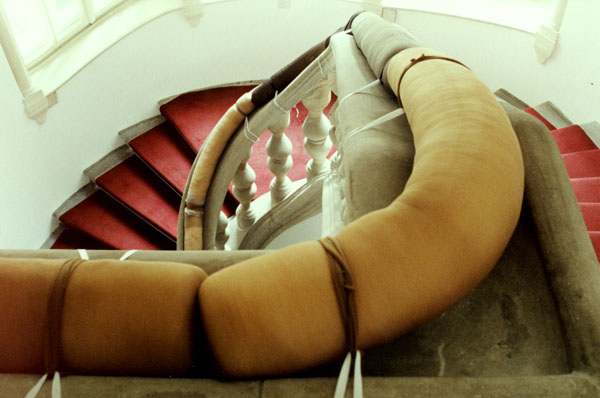
Grzegorz Sztwiertnia
|
Artist - soul doctor,
educator, guide, instructor. There is some irony in Sztwiertnia's literal
understanding of this challenge. Instead of creating "art", he devises
therapies, carries out research and makes designs, employing theoretical
description and practical demonstration. Contemporary art explores the
concept of the body to the full. Sztwiertnia's complement is the problem
of the soul (the spirit?). He does it in a tongue in cheek manner however.
He steers clear of the body factor perceived naturalistically, he embraces
imagination, intellectual play, ambiguity. The artist combines
the objects and images with leaflets, explanations, instructions, and
treatises written in a modern scientific jargon or in an old-fashioned
manner. It compels the viewer to become actively engaged in the interpretation.
The knowledge of specialist medical, psychiatric and psychological terminology
makes it possible to reveal successive layers of meaning connected with
the works, which at first appear as objects just as interesting as incomprehensible.
Jerzy Hanusek (extracts) The project Eurythmicon by Grzegorz Sztwiertnia is composed of several elements and was inspired by Rudolf Steiner's innovative concept of the art of eurhythmics. Eurhythmics is based on considerations and analyses of the nature of human speech, the art of the living word and gesture, and the theatrical expression of "soul" experiences. In his work, Sztwiertnia tries to apply Goethe's Farbenlehre theory, used by Steiner in his investigations, during his work with a mentally handicapped boy who, while playing with a ribbon, vociferates pure, loud sounds. Sztwiernia's analysis of this behaviour led him to create a "natural spectacle" according to the principles of eurhythmics, in the shape of a film. Additionally, the artist arranged the exhibition space to create, as he termed it, an ephemeral visual installation. The film projection is supplemented by colourful ribbons hanging throughout the exhibition hall. Based on science, Sztwiernia creates his new work within the world of art, translating scientific bases into his own rules and principles, and thus implicating the proper reading of it. The artist's experiments are concentrated around the body - its diseases, illnesses and lameness, as well as its functioning and mental states. In this case, the repetition of seemingly nonsensical movements by the boy, overlaps with the first stage of Steiner's theory. Gesture and mimic skills embody the experiences of the soul. Expression of movements, performed unconsciously by the boy, and provoked by the artist by means of the ribbons, allows us to read the state of his soul through the meaning associated with colours. In this case, Sztwiernia's hypothetical action enables the cognition of the spiritual world through catharsis, a kind of healing spectacle. Justyna Niewiara |
|
© 2002 |
|